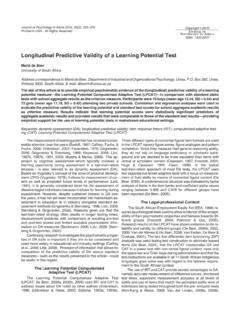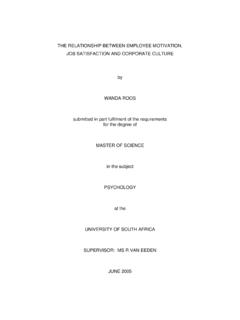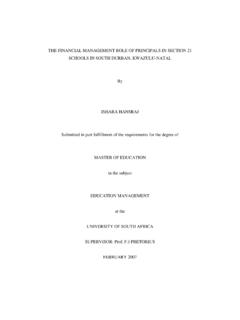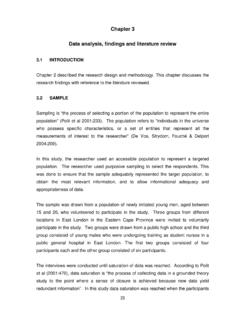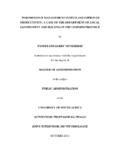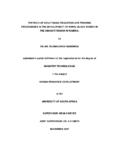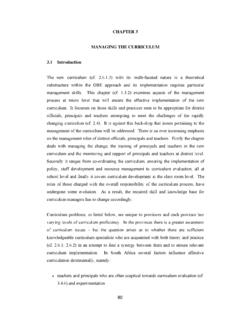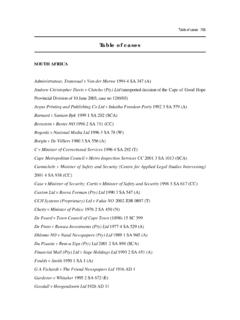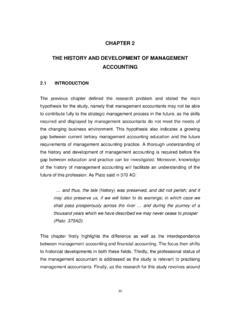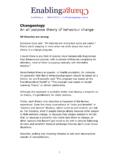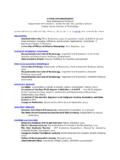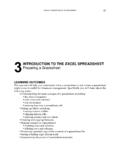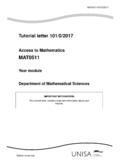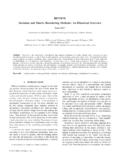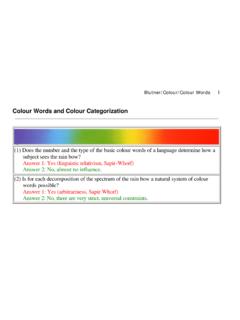Transcription of Appendix A: An outline of OBE principles and ...
1 331 APPENDICES Appendix A: An outline of OBE principles and characteristics some basic principles OBE is an assessment-driven system that operates through the setting up of standards. Qualification/ unit standards are parameters that guide learners and the general public about qualities, values, attitudes, knowledge and skills expected of them as competent citizens, professionals. Outcomes are statements regarding what a student can do and what he/she understands, the contextually demonstrated end products of the learning process. Outcomes are the results of learning processes. It is important that the results of learning processes, viz. knowledge, skills, attitudes and values are seen to be demonstrated within a particular context so that knowledge is applied, skills are developed into competencies, and attitudes and values harmonise with those of society and the workplace.
2 Various types of competencies were identified, with particular focus on applied competence. Applied competence is the ability to put into practice in the relevant context the learning outcomes acquired in obtaining a qualification (SAQA Regulations, March 1998). It is a combination of three types of competence: practical: knowing how to do things, ability to make decisions fundamental: understanding what you are doing and why reflective: learn and adapt through self-reflection; apply knowledge appropriately and responsibly. The focus is thus on output (assessment of competence in terms of pre-determined criteria) rather than input (content), although this does not mean that the knowledge base of a discipline should be neglected. Rather it implies a balance between theoretical and practical relevance.
3 In OBE, each module or qualification should state the desired outcomes and assessment criteria clearly, so that students know in advance what they need to do in order to achieve the outcomes, and assessors understand the criteria by which the outcomes can be reliably and objectively assessed. It is thus necessary that the outcomes are explicit, transparent, distinct and separately considered. Students need to understand clearly what is being assessed and what they are expected to achieve. The assessment criteria need to specify unambiguously the levels of 332 complexity and understanding of knowledge students will be expected to have reached (Mokhobe-Nomvete, 1999). characteristics of OBE OBE is assessment driven: thus assessment criteria must indicate how to determine whether a student has achieved the outcome to a satisfactory standard and what makes the difference between acceptable and unacceptable performance of the outcome.
4 OBE assessment tools are more learner centred than traditional forms of assessment. The OBE philosophy envisages a successful learning experience for all learners. Two broad types of assessment are identified: formative and summative. Both are designed to improve the quality of students= learning experiences by focusing on significant knowledge and skills and to provide accurate estimates of current competence or potential in relation to desired outcomes to enable lecturers to make appropriate decisions. Formative assessment refers to assessment that takes place during the process of learning and teaching. Its purposes may be to diagnose learner strengths and weaknesses, or provide feedback to learners on their progress (or lack thereof). Formative assessment takes place on a continuous basis during the course of learning.
5 Summative assessment takes place at the end of a module or course, and traditionally takes the form of an exam. OBE is criterion referenced, it measures the learner=s achievement against a set of predetermined criteria and not in relation to the achievement of other learners. OBE makes use of clearly stated outcomes and assessment criteria. Each module or qualification states outcomes (known as general, cross-field and specific outcomes) and associated assessment criteria clearly, so that students understand in advance what they have to do to achieve these outcomes and assessors can use the criteria to assess the outcomes with reasonable objectivity/ reliability. OBE permits a variety of assessment methods and instruments. Because assessment assesses a range of elements (knowledge, performance, abilities, etc.)
6 It allows for the use of a variety of assessment methods and instruments. It also allows for the collection of evidence from a variety of sources. 333 Appendix B: Syllabus and outcomes for the Mathematics Access Module The module covers certain topics from school mathematics and relevant applications to real-life situations. The outcomes of the module are that students should learn to take responsibility for their own learning interpret and evaluate mathematical information, represented numerically, algebraically, geometrically, statistically or graphically, in articles appearing in newspapers etc. critically read and interpret mathematical texts interpret and solve mathematical problems, including word problems determine and express mathematically correct solutions to mathematical problems integrate and apply knowledge acquired from different mathematical topics apply mathematical thought processes to real-life situations.
7 The study package for this module consists of six study guides (seven, until the end of 2003) and several tutorial letters; provision is made for a number of assignments students will submit. Originally the assignments contained only multiple-choice questions which were marked by the computer; from 2001 assignments were written and marked by lecturers and external markers. Book 1: Introduction This book includes sections on the outcomes of the module, the way in which the module is structured, the use of the two main types of calculators and some language issues. Topic 1: Welcome and the answers to some questions Topic 2: Calculators Topic 3: Language matters Book 2: Number Skills and Algebra Tools Topic 1: The Set of Real Numbers Section : Kinds of Numbers Study Unit : Terminology Study Unit : Decimal representation of real numbers Study Unit : Ordering on the real number line Study Unit : Intervals 334 Section : Sets Study Unit : Terminology and set operations Topic 2: Operations on Real Numbers Section : Combining Numbers Study Unit : What we know so far Study Unit : Factors, multiples and fractions Section : Rules that Numbers Obey Study Unit : Operations involving integers Study Unit : Properties of real numbers with respect to arithmetic operations Study Unit.
8 Rules that fractions obey Study Unit : Approximation and estimation Topic 3: Ratio, Proportion and Percentage Section : Ratio Study Unit : Ratios involving two quantities Study Unit : Ratios involving more than two quantities Section : Proportion Study Unit : Definition of proportion Study Unit : Problem solving Section : Percentage Study Unit : Why are percentages important? Study Unit : The meaning of percentage Study Unit : Calculations involving percentages Topic 4: Integral Exponents, Scientific Notation and Roots Section : Integral exponents and scientific notation Study Unit : Integral Exponents Study Unit : Scientific notation and estimation Section : Roots and Surds Study Unit : Square roots Study Unit : nth roots (radicals) Study Unit : Surds 335 Topic 5: Units of Measurement Section : Units Study Unit : Metric System Study Unit : Conversion of non-metric to metric units and checking of Units Book 3: More Algebra Tools Topic 1: Algebraic Expressions Section : Introduction to Algebra Study Unit : Words we need to use Section.
9 Basic Algebraic Operations Study Unit : Addition and subtraction Study Unit : Multiplication and division Study Unit : Factorisation Section : Working with Algebraic Fractions Study Unit : Rational expressions Topic 2: Equations and Inequalities Section : Introduction to Equations Study Unit : some terminology of equations Section : Linear Equations and Inequalities Study Unit : Linear equations Study Unit : Solving word problems using linear equations Study Unit : Linear inequalities Section : Quadratic Equations and Inequalities Study Unit : Quadratic equations Study Unit : Solving word problems using quadratic equations Study Unit : Quadratic inequalities Section : some other Equations Study Unit : Solving equations by squaring both sides Study Unit : Changing the subject of a formula Section : Systems of Equations in Two Unknowns Study Unit Systems of linear equations Study Unit : Systems of linear and quadratic equations 336 Topic 3: Sequences Section : Introduction Study Unit : Identifying sequences Section : Arithmetic and Geometric Sequences Study Unit : Arithmetic sequences Study Unit : Geometric sequences Topic 4: Exponents and Logarithms Section : Exponents and Logarithms Study Unit : Rational exponents Study Unit : Equations containing exponents Section : Logarithms Study Unit : Definition and some properties of logarithms Study Unit : Laws of logarithms and the change of base formula Study Unit.
10 Logarithmic Equations Section : Applications of Exponents and Logarithms Study Unit : Introduction Study Unit : Compound interest, appreciation and depreciation Study Unit : Population growth and radioactive decay Book 4: Graphs and Statistics Topic 1: Analytic Geometry : Graphs Study Unit : What is a graph? Section : Cartesian Coordinates and Graphs in the Cartesian plane Study Unit : The Cartesian plane Study Unit : Graphs in the Cartesian plane Section : Formulas we often use Study Unit : The theorem of Pythagoras, distance and midpoint formulas Study Unit : The equation of a circle Topic 2: Relations and Functions Section : Relations and Functions in x 337 Study Unit : Terminology and notation Study Unit : Substitution Section : Combining Functions Study Unit : Addition, subtraction, multiplication and division Topic 3: Straight Lines Section : Straight Lines Study Unit : Graphical representation of a linear equation using a table of values Study Unit : Linear functions and lines Study Unit.
